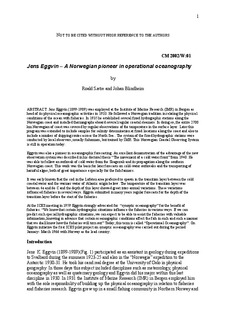| dc.contributor.author | Sætre, Roald | |
| dc.contributor.author | Blindheim, Johan | |
| dc.date.accessioned | 2007-07-16T08:39:16Z | |
| dc.date.issued | 2002 | |
| dc.identifier.uri | http://hdl.handle.net/11250/100525 | |
| dc.description.abstract | Jens Eggvin (1899-1989) was employed at the Institute of Marine Research (IMR) in Bergen as head of its physical oceanographic activities in 1933. He followed a Norwegian tradition in relating the physical conditions of the ocean with fisheries. In 1935 he established several fixed hydrographic stations along the Norwegian coast and installed thermographs aboard several regular coastal steamers. In doing so, the entire 2700 km Norwegian of coast was covered by regular observations of the temperature in the surface layer. Later this program was extended to include samples for salinity determination at fixed locations along the coast and also to include a number of shipping routes across the North Sea.. The system of the fixed hydrographic stations were conducted by local observers, usually fishermen, but trained by IMR. This Norwegian Coastal Observing System is still in operation today.
Eggvin was also a pioneer in oceanographic forecasting. An excellent demonstration of the advantage of the new observation system was described in his doctoral thesis “The movement of a cold water front” from 1940. He was able to follow an outbreak of cold water from the Skagerrak and its propagation along the southern Norwegian coast. This work was the basis for later forecasts on cold-water outbreaks and the transporting of harmful algae, both of great importance especially for the fish farmers.
It was early known that the cod in the Lofoten area preferred to spawn in the transition layer between the cold coastal water and the warmer water of Atlantic origin below. The temperature of the transition layer was between 4o and 6o C and the depth of this layer showed great inter-annual variations. These variations influenced fisheries in several ways. Eggvin submitted in many years regular forecasts for the depth of the transition layer before the start of the fisheries.
At the ICES meeting in 1959 Eggvin strongly advocated for “synoptic oceanography” for the benefit of fisheries. “We know that certain hydrographic situations influence the fisheries in various ways. If we can predict such special hydrographic situations, we can expect to be able to assist the fisheries with valuable information, knowing in advance that certain oceanographic conditions affect the fish in such and such a manner that we shall know how the fisheries will turn out” Today, this term is called “Operational Oceanography”. On Eggvin initiative the first ICES pilot project on synoptic oceanography was carried out during the period January- March 1966 with Norway as the lead country. | en |
| dc.format.extent | 3769252 bytes | |
| dc.format.mimetype | application/pdf | |
| dc.language.iso | eng | en |
| dc.publisher | ICES | en |
| dc.relation.ispartofseries | ICES CM documents | en |
| dc.relation.ispartofseries | 2002/W:01 | en |
| dc.subject | oseanografi | en |
| dc.subject | oceanography | en |
| dc.title | Jens Eggvin – A Norwegian pioneer in operational oceanography | en |
| dc.type | Working paper | en |
| dc.subject.nsi | VDP::Mathematics and natural science: 400::Geosciences: 450::Oceanography: 452 | |
| dc.source.pagenumber | 20 s. | en |
